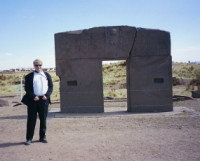
On my tour in Bolivia in July 2002 one of the highlights was
exploring the ancient site of Tiahuanaco. This city constructed of stones is
found at an altitude of 4000 metres (12,500 feet, maybe higher according to
other sources). It's connected with big enigmas that can't be explained easily.
This could be the oldest city in the world, built perhaps, by a civilization of
extraterrestrials, according to some scientists. Traditionally it's believed to
have been built by the predecessors of the Incas over 2,000 years ago.
The impresing stone works at the ruins consist of such structures as the Gate of the
Sun, a portal carved from a single block of stone weighing 15 tons.
Photo. The gate of the sun in Tiahuanaco, an great
ancient wonder in Bolivia.
For 100 years ago a Bolivian scholar Arthur Broznansky
began a 50 year study of the ruins of Tiahuanaca. Using the science of Astronomy
he concluded that the city was constructed more than 17,000 years ago long
before any civilization was supposed to have existed. He called this city the
"Cradle of Civilization".
|
Advertising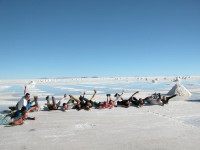 |
Contact
Ranabol Expeditions for more information and
booking your adventure tour in Bolivia:
Manager: Ramiro Cortez
Soria
Address: Ranabol Expeditions, Av.
Ayacucho 112 y Heroínas, Bolivia
Phone
Office: 0591 - 4 - 4583039
Mobile 71717097
Website: www.aventurabolivia.com
E-mail: ranabolraf@hotmail.com |
Bolivia, the diverse country
Bolivia is squeezed
between Peru, Paraguay, Argentina, Brazil and Chile in central South America.
This diverse country is the fifth-largest country on the continent, measuring
roughly the size of France and Spain combined. The country is associated with
myths, legends and hyperbole. Bolivia has the South America's largest percentage
of indigenous people (55 %), the world's largest salt bed (Salar de Uyuni), the
highest navigable lake (Lake Titicaca), and the highest capital city in the
world (La Paz).
Photos. The locals live very steep in the capital La Paz in Bolivia!
My first stop on my South American tour in July 2002 was in La Paz. It looks
like a moon crater and the inhabitants live in the steep hillsides around the
city centre. The city is nearly 4km (2mi) above sea level, situated on a canyon
floor which shows only a hint of greenery. When I landed there the temperature
was below zero and the air was extremely thin. I both froze and gasped strongly
after air. I felt so sick that I nearly had to crawl out of the airport.
Fortunately I felt better when I ascended by taxi down to the city centre.
Photos. Overview La Paz. See Bolivia`s national
fotball stadium.
I can understand why Bolivia is difficult to beat at
home in football. Even Brazil loose against Bolivia here due to the high altitude. It take a time to be acclimated.
The best ting is to take it slow, or it could be risky for your health!
If you want to play football in at such altitude don`t forget to take a deep
breath!
Bloody history
Civilization in the Bolivian
Andes is thought to stretch back some 21,000 years. The most influential
Pre-Columbian cultures was the Tiahuanaco, who was based around Lake Titicaca
and who ruled the region between AD 600-1200, and the Incas, who headed a vast
empire comprising most of Peru, Bolivia, Ecuador and northern Chile.
The Spanish conquest of the country began in 1531 under Francisco Pizarro.
The conquistadors made rapid progress, exploiting the trust (and later the
disunity) of the Indians to secure the territory that within two years became
known as Alto Peru. In 1544, deposits of silver were discovered at Potosí. The
wealth generated by this find underwrote the Spanish economy (and the
extravagance of its monarchs) for more than two centuries. However, conditions
for the mine workers were appalling, with most of the enslaved Indians and
Africans dying within a few years.
The Spanish conquistadors demolished the wonder of Tiahuanaco. Some of the
stones were removed and used for other purposed, for example building a
cathedral nearby. Fortunately it's still traces after an unique ancient
culture.
Tiahuanaco - the lost wonder of the world
The day after I felt better much
from altitude sickness. I took a couple of deep breaths in the morning, and so I
started my tour towards the ruins of Tiahuanaco, a great ancient wonder of
Boliva. It's only a daytrip from La Paz. The ruins are located near the shores
of Lake Titicaca. As mentioned it was in old days the centre of a powerful,
self-sustaining empire in the southern Central Andes.
The roots of the Tiahuanaco capital can be found in the early village
underlying the 1.5-square-mile civic-ceremonial core. The city was settled by
400 B. C. on the Tiahuanaco River, which floats into Lake Titicaca 9.3 miles to
the north. The small farming village evolved into a regal city of multi-terraced
platform pyramids, courts and urban areas, covering a total 2.31 square miles.
|
Photo. Statue.
Tiahuanaco society was self-sustaining, for its agricultural, herding,
and fishing resource base was more than sufficient to support the complex
state administrative apparatus and the population under its control.
|
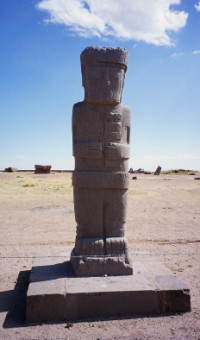 |
The Tiahuanaco
Empire collapsed between 1000 and 1100 A. D. It was a magnificent royal city
that was calculated to inspire awe in the commoners. The walls of the temples
and the stone monolithic statues and gateways are now shorn of their gold,
textiles, and painted surfaces, which for centuries had shimmered from afar in
the bright sunlight.
|
Photo. One of many painted heads on the wall.
As you can see: the stones fit very good together: how have the
people formed the stone so well without advanced equipment? |
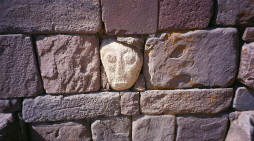 |
The ruins of Tiahuanaco city and centre of worship are located on the
Altiplano in today's Bolivia, ca 4000 m from water level, and 21 km north-east
from Lake Titicaca. Tiahuanaco was a capital of a theocratic state governed by
priest kings. The state exerted its influence on the development of the whole
southern part of Peru in the closing centuries of the last millennium, expanding
its influence in a peaceful manner on the vast highland as well as coastal
territory.
|
Photo. Gate to the ancient temple.
This could be the oldest city in the world, built perhaps, by a
civilization of extraterrestrials, according to some scientists. |
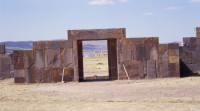 |
Tiahuanaco, therefore, carried out a pacifistic cultural mission quite
different from that of its contemporary militant country of Huari (Wari) in the
Peruvian Andes. The religious sources of this period are first and foremost
archaeological findings, but to a great extent also the recordings of the 16th
century chroniclers.
| Photo. Monoliths with
distinctive stone heads on the walls in the background. |
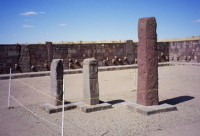 |
Lake Titicaca
On my way further I drove along the beautiful Lake Titicaca.
Traditionally has this lake been considered as the highest lake in the world
though there are higher lakes in Chile and Peru. Lake Titicaca is immense: its
dimensions measure 233km (145mi) from northwest to southeast and 97km (60mi)
from northeast to southwest.
|
Photo. Lake Titicaca.
The lake has an indented shoreline, 36 islands and exceptionally clear
sapphire-blue water. |
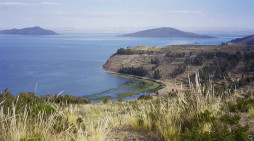 |
Titicaca is revered by the Indians who live on its
shores, and the Islas del Sol and Islas de la Luna, two islands in the lake, are
the legendary sites of the Inca's creation myths. The main town in the area is
Copacabana, which has a sparkling white Moorish-style cathedral and is host to
the Fiesta de la Virgen de Candelaria.
Research and excavations are still going on to find
more about the Tiahuanaco ruins and life in past. Will ever scientists solve the
mysteries connected to the place and culture? It is possible today to find lost
knowledge from exploring ancient wonders that we can use in our modern
world?
This article continues in part 2: read about
amazing theories from scientists.
Stein Morten Lund, 22 July 2004
Additional information
Presentation of
our partner in Bolivia (sponsored presentation and link):
****************************************************************************************************************
Ranabol Expeditions, Boliva - taking you into
unexplored areas
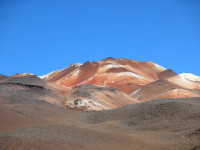 The company is a pioneer in expeditions
and unique adventures in Bolivia. It
has specialised on trekking tours to untouched places in high mountains and
tropical jungles. Some parts are still unexplored in Bolivia. The company`s
guides know well areas as Incallajta, Toro Toro, Samaipata, Tunari,
Chapare, Villa Tunari, Isiboro Sécure, Parque Amboró, Incachaca and many other
places.
The company is a pioneer in expeditions
and unique adventures in Bolivia. It
has specialised on trekking tours to untouched places in high mountains and
tropical jungles. Some parts are still unexplored in Bolivia. The company`s
guides know well areas as Incallajta, Toro Toro, Samaipata, Tunari,
Chapare, Villa Tunari, Isiboro Sécure, Parque Amboró, Incachaca and many other
places.
Ranabol arranges
expeditions to the Devil's Canyon where you will travel by
canoe on the Grande
River. On these
tours there will be great opportunities to visit archaeological places (Inca
sites etc), watch huge dinosaur prints, study cave
paintings, admire hot springs and canyons with vertical walls.
You can also
observe a unique wildlife in the area as condors, elks, deer, and also for
fishing so you can make your own food in the wilderness. Several other animals species can be found in areas around as
the endemic and endangered red frontered macaw, the andean cat, mountain lions,
parakeets, and many species of songbirds.
Ranabol take you
to unique places where you can experience the rich culture in the country.
Bolivian culture has many Inca and other Indian influences in religion, music
and clothing. The most well known fiesta is the UNESCO heritage "El carnaval de
Oruro". Bolivia has long been inhabited by advanced cultures, the most important
being the civilization of Tiahuanaco. The country is full of ancient mysteries
waiting for being solved, and exploring this important Pre-Columbian
archaeological site, is something that really makes you excited. The ruins of
the Tiahuanaco are on the eastern shore of Lake Titicaca, about 72 km (44 miles)
west of Bolivia's capital La Paz.
 Going by Ranabol you can also
experience Bolivia's many great natural wonders. One of the greatest is Lake
Titicaca (Spanish: Lago Titicaca), which is South America's largest lake and,
considered to be the highest navigable lake in the world. Another great wonder
is the Salar de Uyuni, which is the world's largest salt flat. Located 3650
meter high, Salar de Uyuni sits in the Departmento of Potosí in southwest
Bolivia near the crest of the Andes. It's now a centre for salt extraction and
processing in Colchani; Ojos del Salar. In some areas in the salt flat, cold
underground water rises to the surface and bubbles up through the salt layer,
creating unusual shapes from the eruptions of the salt. Isla del Pescado is a
hilly outpost covered with cactuses and surrounded by a flat, white sea
hexagonal salt tile. Other natural wonders in Bolivia
are Volcan Tunupa, Lake Colorada, and Lake Verde.
Going by Ranabol you can also
experience Bolivia's many great natural wonders. One of the greatest is Lake
Titicaca (Spanish: Lago Titicaca), which is South America's largest lake and,
considered to be the highest navigable lake in the world. Another great wonder
is the Salar de Uyuni, which is the world's largest salt flat. Located 3650
meter high, Salar de Uyuni sits in the Departmento of Potosí in southwest
Bolivia near the crest of the Andes. It's now a centre for salt extraction and
processing in Colchani; Ojos del Salar. In some areas in the salt flat, cold
underground water rises to the surface and bubbles up through the salt layer,
creating unusual shapes from the eruptions of the salt. Isla del Pescado is a
hilly outpost covered with cactuses and surrounded by a flat, white sea
hexagonal salt tile. Other natural wonders in Bolivia
are Volcan Tunupa, Lake Colorada, and Lake Verde.
Ranabol
Expeditions also offer several challenging activities as rafting, kayaking,
trekking, rappelling, canoeing, paragliding,
mountain biking etc. Contact the company for more
information and suggestions.
Contact info:
Manager: Ramiro
Cortez Soria
Address: Ranabol
Expeditions, Av. Ayacucho 112 y
Heroínas, Bolivia
Phone Office: 0591 - 4 - 4583039
Mobile
71717097
Website: www.aventurabolivia.com
E-mail: ranabolraf@hotmail.com
****************************************************************************************************************
Facts about Bolivia:
Formal country name: Republic of
Bolivia.
Area: 1.09 million sq km.
Population: 8.8 million.
People: 30%
Quechua Indian, 25% mestizo, 30% Aymará Indian, approx 15% European (principally
Spanish).
Language: Quechua, Aymara, Spanish; Castilian and Ga.
Religion:
95% Roman Catholic, Protestant (Evangelical Methodist).
Government:
republic.
